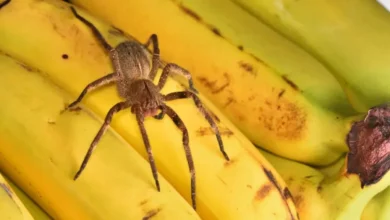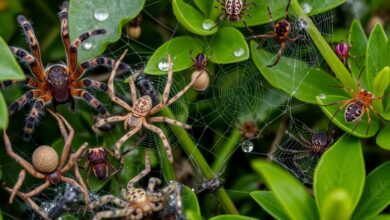Why are black widow spiders so deadly?
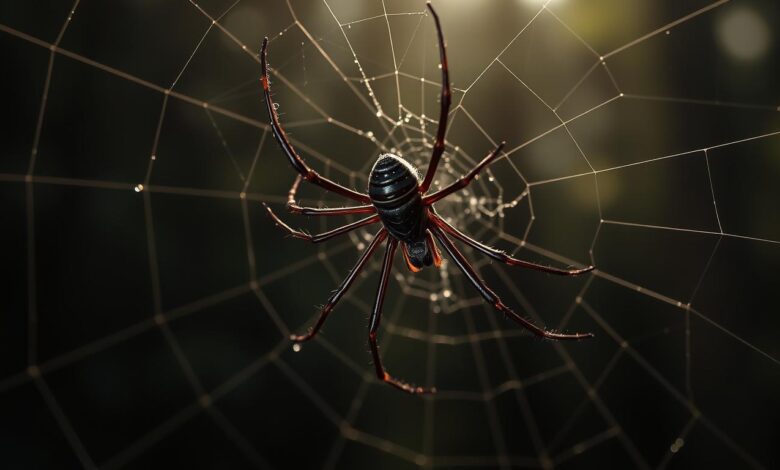
Black widow spiders are among the most venomous in North America. Their venom is very potent and can cause serious symptoms. These include muscle pain, nausea, and breathing problems. In some cases, their bites can be deadly, especially for kids and the elderly.
It’s important to know about their venom, symptoms, and how to prevent bites. This knowledge helps keep us safe from these dangerous spiders.
Their venom has a powerful neurotoxin called alpha-latrotoxin. It attacks the nervous system, disrupting signals between neurons and muscles. This can cause severe pain, muscle spasms, breathing issues, and even paralysis.
While most black widow bites are not fatal, they need quick medical attention. This helps prevent serious complications and long-term health issues.
To avoid black widow spiders, you should know how to spot them. Look for their black color and the red hourglass marking on their belly. They like dark, quiet places like woodpiles, sheds, and crawl spaces.
So, be careful when working in these areas. If bitten, get medical help right away. Also, apply first aid to lessen the symptoms.
The Black Widow’s Potent Venom
The black widow spider is known for its deadly venom. It contains a powerful neurotoxin called alpha-latrotoxin. This venom attacks the nervous system, causing severe muscle pain, nausea, and breathing problems.
Neurotoxin Composition and Effects
The black widow’s venom mainly has this neurotoxin. It messes with the signals between the nervous system and muscles. This can lead to serious symptoms, including:
- Severe muscle pain and cramping
- Nausea and vomiting
- Difficulty breathing
- High blood pressure and sweating
Bite Symptoms and Severity
The effects of a black widow bite can start within 30 minutes to an hour. While the symptoms are very uncomfortable, they rarely threaten life in healthy adults. But, in young children, the elderly, or those with weak immune systems, a bite can be deadly if not treated right away.
It’s vital to get medical help quickly for a black widow bite. The venom’s strength and how severe the reaction is can vary. Even if the symptoms seem mild at first, getting professional advice and monitoring is key.
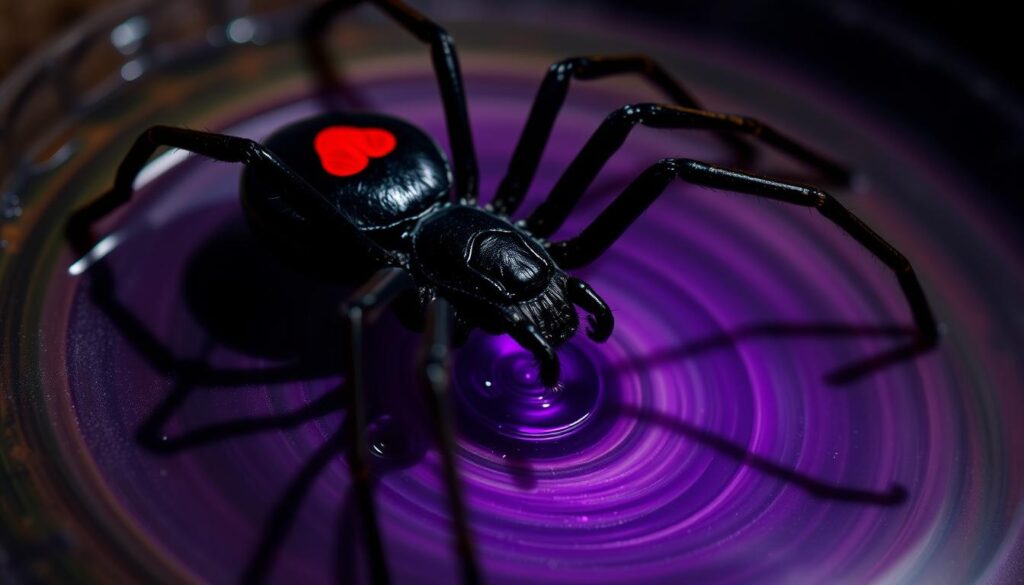
Identifying Black Widow Spiders
The black widow spider is easy to spot because of its shiny black body and red hourglass mark. Females are bigger and bite more often than males.
Physical Appearance and Markings
Black widow spiders have a round body and long legs, up to 1.5 inches long. Females are bigger, reaching up to 1.5 inches. Their red hourglass mark on the belly is very noticeable.
There are many black widow species worldwide. The Latrodectus mactans is common in North America. Other species, like the Latrodectus hesperus and Latrodectus geometricus, have similar hourglass marks.
| Spider Species | Abdominal Markings | Geographic Range |
|---|---|---|
| Latrodectus mactans (Southern Black Widow) | Distinctive red hourglass shape | Eastern and Central United States |
| Latrodectus hesperus (Western Black Widow) | Distinctive red hourglass shape | Western United States and Canada |
| Latrodectus geometricus (Brown Widow) | Yellowish hourglass shape | Southern United States, primarily in the Gulf Coast region |
Learning to spot these spiders is key to staying safe and avoiding bites.
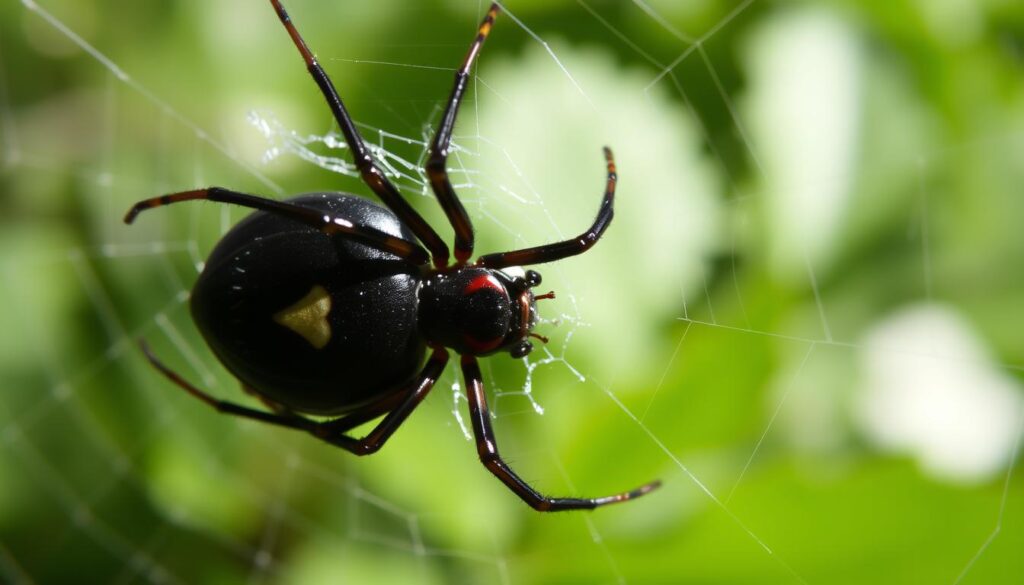
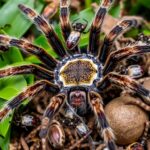 Tarantulas vs Spiders: Are They Different Creatures?
Tarantulas vs Spiders: Are They Different Creatures?
Black Widow Habitat and Range
Black widow spiders are found in the U.S., Canada, and parts of Mexico. They love warm, dry places and live in woodpiles, sheds, and garages. They also build webs in spots where people often sit, like under outdoor furniture.
The southern black widow is common in the U.S. southeast. The northern black widow is found along the East Coast. The western black widow lives in western states, like California. Knowing where they live helps us stay safe.
It’s important to know where black widow spiders live. This helps us avoid them. By understanding their habitats, we can take steps to stay safe.
Spider Bite Prevention and Safety
Preventing bites from venomous spiders like the black widow is crucial. Being alert and taking steps ahead can lower the chance of running into these spiders. Always be aware of your surroundings, especially in places where black widows might hide, like woodpiles or sheds.
Wearing gloves and long sleeves can also help protect you from spider bites. This extra layer of clothing can make a big difference.
Reducing Spider Encounters
Keeping your home and yard clean can also keep spiders away. Remove clutter, seal up cracks, and get rid of places where spiders might nest. This makes your place less appealing to them.
Using insect repellent outside can also help protect you from spider bites. It adds an extra layer of safety.
First Aid for Black Widow Bites
If you get bitten by a black widow, get medical help right away. The venom can be very dangerous, and quick treatment is key. While waiting for help, keep the bite clean, use a cold compress, and avoid moving too much.
Being proactive and informed can greatly reduce the risk of spider bites. This way, you can stay safe from these dangerous spiders.
Why are black widow spiders so deadly?
Black widow spiders are among the deadliest in North America. Their venom has a powerful neurotoxin called alpha-latrotoxin. This toxin can severely harm the human body.
When a black widow bites, this toxin attacks the nervous system. It causes spider bite symptoms like muscle pain, nausea, and breathing problems. In rare cases, it can even be fatal.
The severity of a black widow bite varies. It depends on the venom amount, the person’s health, and how quickly they get medical help. While most bites aren’t fatal, they can be very dangerous and need immediate care. The black widow venom is so strong that it can be deadly if not treated right away.
| Spider Bite Symptoms | Bite Severity |
|---|---|
| Muscle pain, nausea, respiratory distress | Potentially life-threatening if not treated promptly |
The black widow spiders are so deadly because of their venom. Knowing the dangers they pose is key to staying safe. It’s also important to seek medical help if bitten.
Black Widow Ecology and Behavior
Black widow spiders live alone and are active at night. Females are bigger and more aggressive than males. They have interesting ways of living, from how they mate to their life stages.
Mating Habits and Life Cycle
When it’s time to mate, the male black widow spider is very careful. He approaches the female’s web, knowing she might eat him after mating. Females can lay up to 400 eggs in silk sacs.
The eggs hatch into spiderlings, which then spread out. They grow up and can make their own venom. Black widow spiders are important in their ecosystems. They help keep the balance of nature.
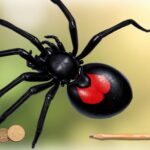 How Big Is a Black Widow Spider? Size Guide
How Big Is a Black Widow Spider? Size Guide
| Characteristic | Details |
|---|---|
| Solitary Behavior | Black widow spiders are solitary creatures, with females being larger and more aggressive than males. |
| Nocturnal Activity | These spiders are primarily active at night, hunting and engaging in various behaviors. |
| Mating Rituals | During mating, the male approaches the female’s web cautiously, and the female may sometimes consume the male after copulation. |
| Egg Laying | Females lay their eggs in silk sacs, which can contain up to 400 eggs. |
| Spiderling Dispersal | The young spiderlings emerge from the sac and disperse, eventually reaching adulthood and becoming capable of producing their own deadly venom. |
Black widow spiders are key to their ecosystems. They help keep spider populations balanced. By studying their mating and life cycle, we learn more about these fascinating spiders.
Venomous Spider Control Methods
Dealing with venomous spiders, like the black widow, can be tough. But, there are ways to handle it. You can choose to hire pest control services or manage it yourself. Knowing the best methods can help reduce the dangers from these venomous arachnids.
Getting help from pest control experts is a smart move. They use special insecticides or remove webs to get rid of spiders. This way, they can control and eradicate the spiders from your home.
If you want to do it yourself, there are steps you can take. Sealing up cracks, removing woodpiles, and planting spider-repelling plants can help. These actions make your home less appealing to spiders.
It doesn’t matter how you choose to handle it, being careful and knowing what you’re dealing with is crucial. By staying alert and informed, you can manage the risk of venomous spiders in your area.
Comparing Black Widows to Other Venomous Spiders
Black widow spiders are known for being venomous in North America. But they’re not the only danger. Other spiders like the brown recluse, hobo spider, and tarantula also pose risks. Knowing the differences helps us identify and handle these spiders better.
Black Widow Spiders
Black widow spiders have a red hourglass on their black belly. Their venom is a powerful neurotoxin. It can cause pain, muscle spasms, and rarely, death. Yet, not all bites are fatal, and symptoms vary by person and venom amount.
Other Venomous Spiders
- Brown Recluse Spiders are smaller than black widows. Their venom can cause skin and tissue damage. Their bites are generally milder.
- Hobo Spiders were once thought to be aggressive. But studies show their bites are unlikely to cause serious harm.
- Tarantulas are the biggest spiders in North America. Their venom is not a big threat. Most bites cause only mild reactions.
These spiders can all bite and deliver venom. But the danger they pose varies. Knowing each species’ traits helps us stay safe and react wisely if we meet them.
| Spider Species | Size | Venom Potency | Bite Symptoms |
|---|---|---|---|
| Black Widow | 1.5 inches | Highly Potent | Severe pain, muscle spasms, respiratory distress |
| Brown Recluse | 0.375 inches | Moderately Potent | Tissue necrosis, mild to moderate pain |
| Hobo Spider | 0.75 inches | Mild | Mild pain, possible swelling |
| Tarantula | 2 to 8 inches | Mild | Mild pain, possible irritation |
Historical Accounts of Black Widow Bites
Black widow bites have been documented throughout history. These accounts often show the venom’s effects in alarming ways. In the early 20th century, bites were sometimes misdiagnosed or seen as supernatural. This led to many misconceptions about these spiders.
As we learned more about black widow venom, our views on them changed. They are still feared and fascinating to many.
The first recorded black widow bite was in 1850 in California. A young boy was bitten by a spider later identified as a black widow. He suffered from severe pain, muscle spasms, and trouble breathing. Some thought he was cursed or possessed.
In the early 1900s, bites were often mistaken for tetanus or other serious conditions. This was because the venom’s effects were not well understood. But as research improved, we learned more about black widow venom. We also found ways to treat its effects.
| Year | Location | Victim | Symptoms |
|---|---|---|---|
| 1850 | California | Young boy | Intense pain, muscle spasms, difficulty breathing |
| 1908 | New York | Adult male | Severe abdominal pain, nausea, respiratory distress |
| 1930 | Texas | Elderly woman | Paralysis, elevated blood pressure, sweating |
As we learned more about black widow spiders, education and medical care improved. Today, while they are still dangerous, bites are much less likely to be fatal. However, they can still cause a lot of discomfort and health issues.
Myths and Misconceptions About Black Widows
Black widow spiders have a scary reputation, but many myths surround them. For instance, their venom isn’t the deadliest of all spiders. Other spiders, like the Brazilian wandering spider, have venom that’s even more dangerous.
It’s also wrong to think that all black widow bites are deadly. The impact of a bite can vary a lot. Thanks to modern medicine, most people who get bitten can recover well. In fact, there are hardly any reports of black widow bites leading to anymore.
It’s important to clear up these myths to keep people safe. Knowing the truth about black widows helps us understand them better. This way, we can avoid dangerous situations and respect these spiders’ place in nature.
 How strong is a black widow spider web?
How strong is a black widow spider web?

